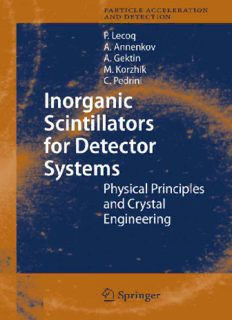Table Of ContentInorganic Scintillators forDetectorSystems
Particle Acceleration and Detection
springer.com
TheseriesParticleAccelerationandDetectionisdevotedtomonographtextsdealing
withallaspectsofparticleaccelerationanddetectionresearchandadvancedteach-
ing.Thescopealsoincludestopicssuchasbeamphysicsandinstrumentationaswell
asapplications.Presentationsshouldstronglyemphasisetheunderlyingphysicaland
engineeringsciences.Ofparticularinterestare
• contributions which relate fundamental research to new applications beyond
theimmediaterealmoftheoriginalfieldofresearch
• contributionswhichconnectfundamentalresearchintheaforementionedfields
tofundamentalresearchinrelatedphysicalorengineeringsciences
• conciseaccountsofnewlyemergingimportanttopicsthatareembeddedina
broaderframeworkinordertoprovidequickbutreadableaccessofverynew
materialtoalargeraudience
The books forming this collection will be of importance for graduate students and
activeresearchersalike.
SeriesEditors:
ProfessorAlexanderChao ProfessorTakahikoKondo
SLAC KEK
2575SandHillRoad BuildingNo.3,Room319
MenloPark,CA94025 1-1Oho,1-21-2Tsukuba
USA 1-31-3Ibaraki305
Japan
ProfessorChristianW.Fabjan
CERN ProfessorFrancesoRuggiero
PPEDivision CERN
1211Genève23 SLDivision
Switzerland 1211Genève23
Switzerland
ProfessorRolf-DieterHeuer
DESY
Gebäude1d/25
22603Hamburg
Germany
X
Paul Lecoq Alexander Annenkov Alexander Gektin
Mikhail Korzhik Christian Pedrini
Inorganic Scintillators
for Detector Systems
Physical Principles and Crystal Engineering
With125Figures
ABC
PaulLecoq MikhailKorzhik
CERN,EuropeanOrganizationfor InstituteofNuclearProblems
NuclearResearch Bobruiskayaul.11
1211Geneva23 220050Minsk
Switzerland Belarus
E-mail:paul.lecoq@cern.ch E-mail:mikhail.korjik@cern.ch
AlexanderAnnenkov ChristianPedrini
BogoroditskTechnoChemicalPlant UniversitéLyon1
301801Bogoroditsk LPCML,4MR5620CNRS
TulaRegion Baˆt.A.Kastler
RussianFederation 10rueAmpère
E-mail:annenkov@btcp.tdn.ru DomaineScientifiquedelaDoua
69622VilleurbanneCedex
France
AlexanderGektin E-mail:pedrini@pcml.univ-lyon1.fr
InstituteforScintillationMaterials
LeninAvenue60
310001Kharkov
Ukraine
E-mail:gektin@isc.kharkov.com
LibraryofCongressControlNumber:2005933613
ISSN1611-1052
ISBN-10 3-540-27766-8SpringerBerlinHeidelbergNewYork
ISBN-13 978-3-540-27766-8SpringerBerlinHeidelbergNewYork
Thisworkissubjecttocopyright.Allrightsarereserved,whetherthewholeorpartofthematerialis
concerned,specificallytherightsoftranslation,reprinting,reuseofillustrations,recitation,broadcasting,
reproductiononmicrofilmorinanyotherway,andstorageindatabanks.Duplicationofthispublication
orpartsthereofispermittedonlyundertheprovisionsoftheGermanCopyrightLawofSeptember9,
1965,initscurrentversion,andpermissionforusemustalwaysbeobtainedfromSpringer.Violationsare
liableforprosecutionundertheGermanCopyrightLaw.
SpringerisapartofSpringerScience+BusinessMedia
springer.com
(cid:1)c Springer-VerlagBerlinHeidelberg2006
PrintedinTheNetherlands
Theuseofgeneraldescriptivenames,registerednames,trademarks,etc.inthispublicationdoesnotimply,
evenintheabsenceofaspecificstatement,thatsuchnamesareexemptfromtherelevantprotectivelaws
andregulationsandthereforefreeforgeneraluse.
Typesetting:bytheauthorsandTechBooksusingaSpringerLATEXmacropackage
Coverdesign:design&productionGmbH,Heidelberg
Printedonacid-freepaper SPIN:10988435 54/TechBooks 543210
Preface
Thelasttwodecadeshaveseenaspectacularincreaseofinterestforinorganic
scintillators.Thishasbeentoalargepartaconsequenceofthevisibilitygiven
to this field by several large crystal-based detectors in particle physics. To
answer the very challenging requirements for these experiments (huge data
rates, linearity of response over a large dynamic range, harsh radiation envi-
ronment, impressive crystal quantities to be produced in a short time period
and at an affordable cost, etc...) an effort of coordination was needed. Sev-
eral groups of experts working in different aspects of material science have
combinedtheireffortsininternationalandmultidisciplinarycollaborationsto
better understand the fundamental mechanisms underlying the scintillation
processanditsefficiency.Similarly,thestabilityofthescintillationproperties
andtheroleofcolorcentershasbeenextensivelystudiedtodevelopradiation
hard scintillators. Dedicated conferences on inorganic scintillators have seen
an increasing participation from different communities of users outside the
domain of high-energy physics. This includes nuclear physics, astrophysics,
security systems, industrial applications, and medical imaging. This last do-
maininparticularisgrowingveryfastsinceafewyearsatthepointthatthe
volume of scintillating crystals to be produced for positron emission tomog-
raphy(PET)isgoingtoexceedtheoneforhigh-energyphysics.Asmoreand
more crystal producers are also attending these conferences, a very fruitful
synergy was progressively built up among scientific experts, technologists,
and end users. This aspect of a multidisciplinary collaboration is essential to
helppeopledesignandbuilddetectorsofever-increasingperformancethrough
the choice, optimization or development of the best scintillator, and a thor-
ough investigation of the technologies to produce the crystals of the highest
quality.
The idea for this book was born during one of the conferences of the
SCINT cycle (eight conferences since the first one in Chamonix, France, in
September 1992). It appears that the progress in understanding scintillation
process and in material sciences in general opens new ways to answer the
challengingrequirementsofanincreasingnumberofcustomers.Whereasun-
til recently the only possibility was to scan scintillator databases to select,
among the few which are available, the one having reasonable properties,
very often at the price of important compromises, the dream of engineering
VI Preface
scintillators closely matching the user’s requirements is becoming every day
more realistic. This is why we have deliberately taken the end user’s view-
point. This book does not follow an academic scenario, starting from theo-
retical considerations, describing the different scintillation mechanisms in a
didactic way, and concluding with a few examples. Several authors have al-
readypublishedexcellentmonographsofthatsort.Wehavechoseninsteada
more pragmatic approach trying to answer practical problems and insisting
on limiting factors which are not only of theoretical nature but also related
to technological difficulties, production yield, and cost.
This book is therefore a practical guide for people, scientists, and engi-
neers who intend to develop a detector using inorganic scintillators for basic
research,medicalimaging,orindustrialapplications.Itwillalsointereststu-
dents and teachers to get an overall picture of a field in rapid expansion. Its
multidisciplinary approach is a good illustration of how modern challenges
are met. It does not address organic and liquid scintillators.
Theintroductiondefinesthevocabularyanddescribesthedifferentclasses
ofscintillators.Definitionsofluminescence,scintillation,andphosphorescence
are given. The main parameters of interest for scintillating materials are
described with a short and comprehensive definition for each of them.
The following chapter reviews the user’s requirements for the different
applications. Starting from the problem to be solved in domains as different
as fundamental physics, medical imaging, security systems, oil well logging,
andotherindustrialapplications,itexplainshowtheserequirementsinfluence
the development of new scintillators.
Thechapteronscintillationmechanismininorganicscintillatorsistreated
in a practical way. The point is to show how to answer high light yield,
short decay time, good energy resolution, etc...as requested by users. The
fundamentalmechanismsareofcourseexplained,butaparticularemphasisis
put on the description of factors limiting these performances in good-quality
crystals.
In the next section the influence of crystal defects and their role in the
degradationofthescintillatorperformanceisthoroughlystudied.Inparticu-
lar,problemsofnonlinearityofthescintillatorresponseandradiationdamage
are discussed.
At this stage it is important to address the problems of crystal engineer-
ing. This isthe subject of the next chapter wherethe reader will get familiar
with the most frequently used technologies of crystal growth and their lim-
itations. The mechanical processing and different methods to optimize the
light collection are also discussed in this part.
Finally, two examples of recently developed scintillators are given as an
illustration of the approach proposed in this book. The first one describes
the huge effort on Lead Tungstate (PWO) for the largest electromagnetic
calorimeter ever built in high-energy physics. The second one concerns the
Preface VII
developmentoftheLutetiumAluminumperovskite(LuAP)formedicalimag-
ing devices.
The authors hope through their work to contribute to the development
of this very active domain of material sciences, to help the people interested
in the use of inorganic scintillators, and to promote education in this field.
Acknowledgments
Theauthorsexpresstheirwarmthankstoalltheircolleagueswhocontributed
a lot with their research to the development of new scintillation materials.
Special thanks go to the members of the Crystal Clear Collaboration, the
CMS Collaboration at CERN, the CERN management, the ISTC Founda-
tion, the different National Science Funding Agencies for their support to
this research. We are also very grateful to Dr. S. Sytova for her efficient
technical support for assembling the book. Finally the authors express their
gratitude to Dr. A. Fedorov, Dr. O. Missevitch, Dr. A. Hofstaetter, Dr. R.
Novotny,Dr.M.Kirm,Dr.P.Dorenbos,Dr.A.Belsky,Prof.A.Vasil’ev,and
Prof. V. Mikhailin for collaborative research and fruitful discussions at the
preparation of this book.
August 2005 Paul Lecoq
X
Description:The development of new scintillators as components of modern detector systems is increasingly defined by the end user's needs. This book provides an introduction to this emerging topic at the interface of physics and materials sciences, with emphasis on bulk inorganic scintillators. After surveying

